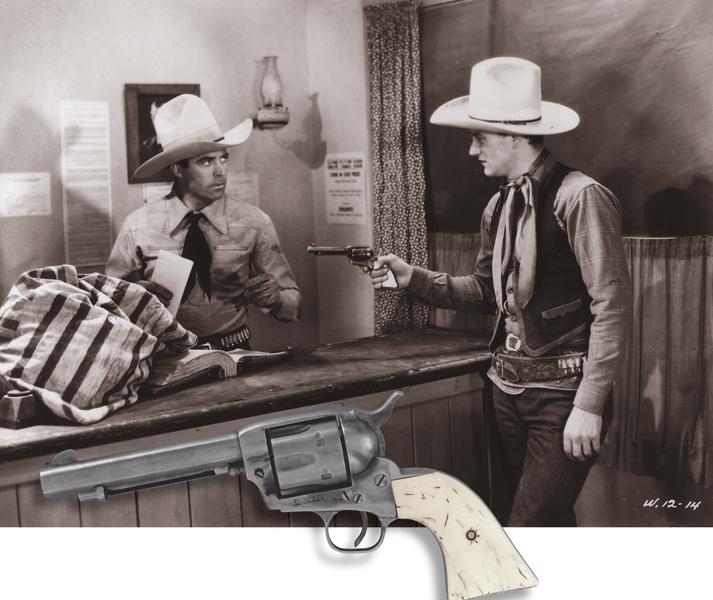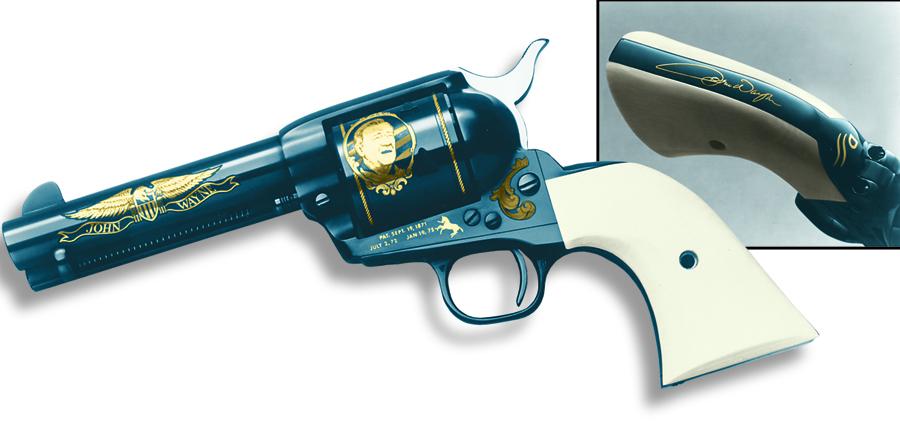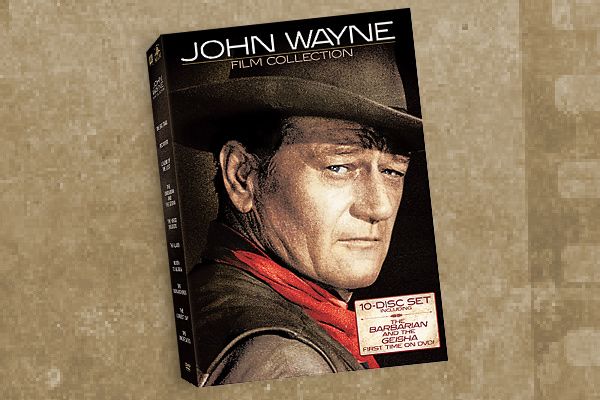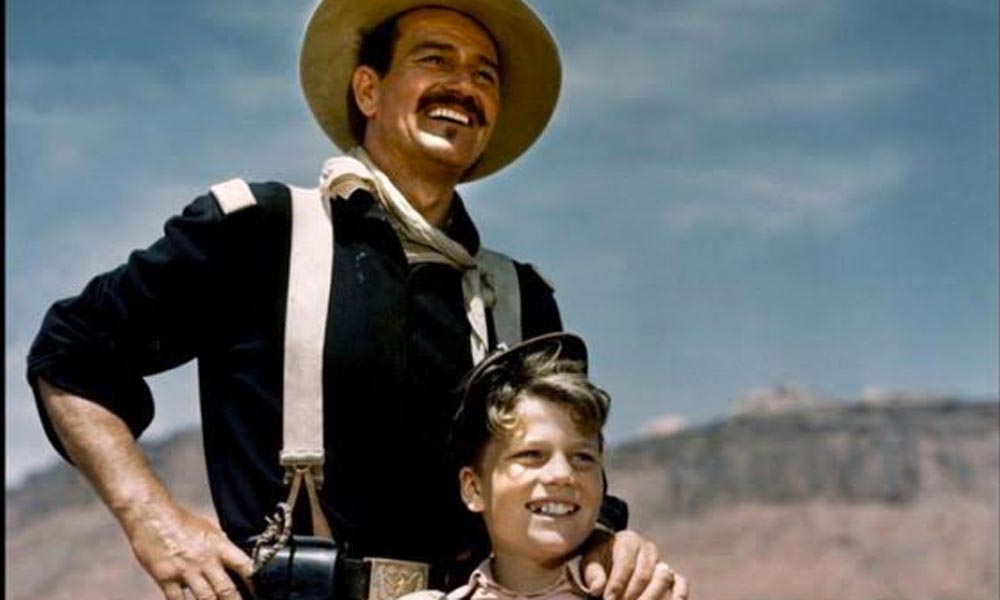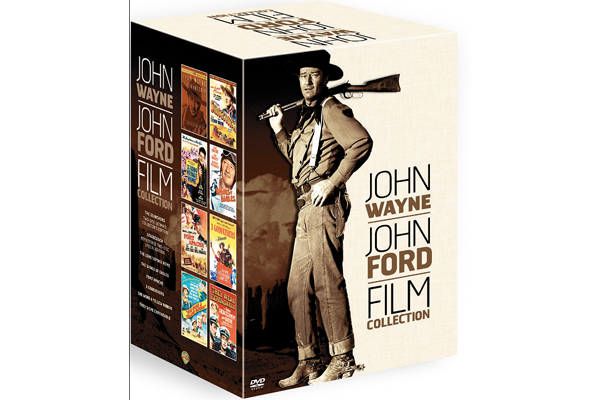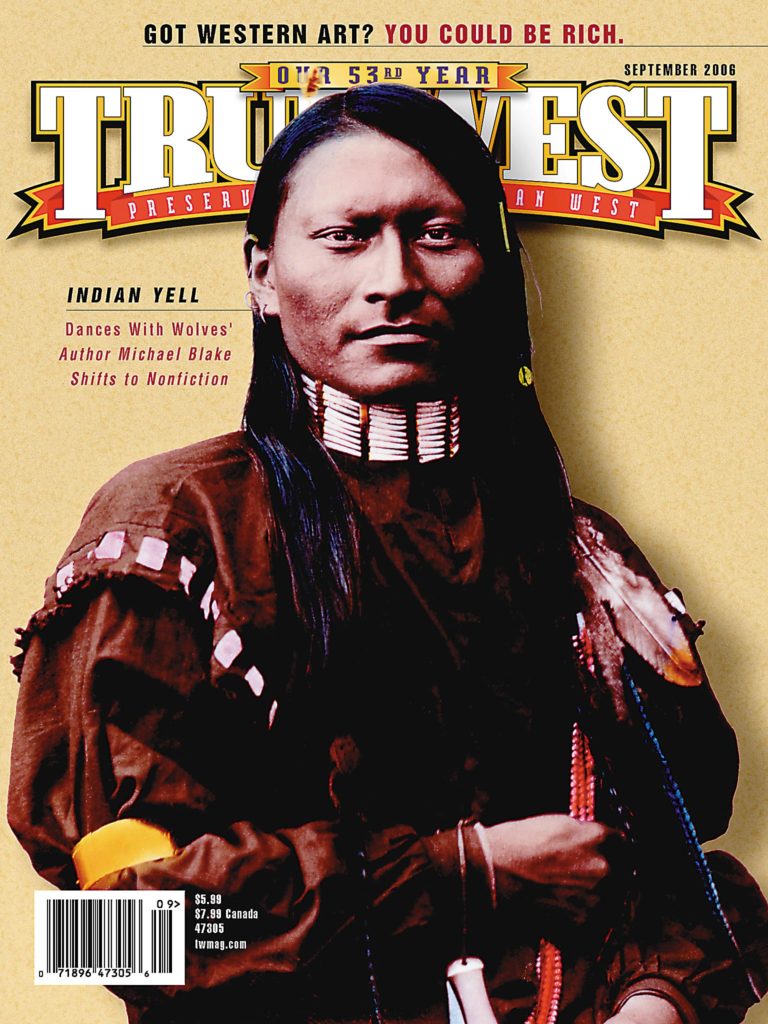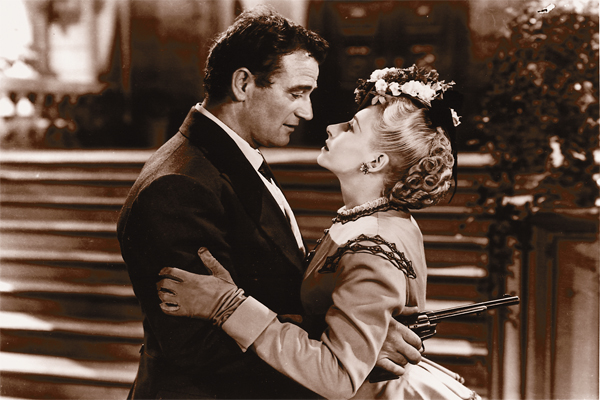 On film, John Wayne often portrayed the Westerner of popular legend—tall in the saddle, silent, a man whose word was his bond, perhaps sometimes bullheaded, but always strong and never petty.
On film, John Wayne often portrayed the Westerner of popular legend—tall in the saddle, silent, a man whose word was his bond, perhaps sometimes bullheaded, but always strong and never petty.
For nearly a half century, in more than 150 films—many of them Westerns—the Duke blazed his way across the silver screen and became much more than the undisputed largest box office star of all time. He became an American icon—the very symbol of our country. Despite his passing nearly three decades ago, it’s been estimated that somewhere in the world, at any given time, someone is watching a John Wayne movie.
In many of these films (primarily his Oaters), Big John relied on one type of six-gun more than any other—the classic 1873 Colt Single Action Army (SAA). Together, the Duke and his Colt Peacemaker presented an image that bespoke of the Old West. About the only time he used a different handgun in a Western was in 1930, when he starred in his first major movie, The Big Trail. In this covered wagon saga, he packed a Remington 1861 New Model Army .44 revolver (converted to metallic cartridge to handle motion picture blank ammunition). Initially, Big John relied on his Colt SAA because it was the gun supplied to him by the prop departments of the films he was working on. And, of course, virtually every movie cowboy worth his saddle packed a Peacemaker in those days.
Early on, the Duke learned how to twirl, perform a fast draw, fan and generally handle his Colt SAA with complete skill and ease. Although the actor seldom flaunted his six-gun tricks, if he felt his character would have done one, then he performed a quick twirl or a fancy flip here and there. Such understated, yet impressive gun handling by Wayne can be seen in films such as The Searchers.
In later years, when Duke’s stature in the motion picture business was such that he could dictate his costuming and other props, he was known to select the old standby SAA; eventually, he supplied his own personal Colt.
Wayne’s fondness for the Colt superseded the facts, at times. He used it in 1961’s The Comancheros, which was set in Texas in the 1830s—40 years before the introduction of the Colt SAA. The Duke tamed the big screen’s bad guys with his Peacemaker, and nobody ever complained. After all, one could easily forget the scripted date of this fictionalized story and enjoy the film—besides, who would want to argue with the Duke?
Back in the early 1930s, after finishing The Big Trail, Wayne found himself acting in one low-budget B-Western after another. Often working with the same crew on these quickie shoot-’em-ups, he began using the same gunbelt and revolver. The revolver he used in most of those trail dust sagas was a 51?2-inch barreled, .38-40 caliber Colt SAA that was fitted with ivory stocks. According to the serial numbers on this six-gun, it was shipped from the Colt factory in 1928, so it would have been only a few years old when the Duke started taming the Saturday matinees in Oaters such as Lucky Texan, Blue Steel, The Man from Utah, Lawless Frontier and Randy Rides Alone.
The late Michael Wayne, oldest son of the Duke and producer of a number of his dad’s movies, said cinematographer A.J. “Archie” Stout gave this 51?2-inch barreled hog leg to his father, many years after the Duke had completed his contract for B-Westerns. John Wayne later gave the revolver to Michael, who cherished it for the rest of his life. Upon Michael’s death, Little John’s Auction Service of Orange County, California, sold this Colt in November 2003 for a bid of $20,000.
One Western made the Duke a star to be reckoned with—1939’s Stagecoach, in which Wayne’s character, “The Ringo Kid,” didn’t even carry a six-gun! Wayne still had a handful of B-Westerns to finish, but upon their completion, he moved on to star in one major feature after another—several of them Westerns. The Duke, then in his mid-30s, used a variety of nondescript Colt SAAs. Most of his revolvers were of the short 43?4-inch barreled model. He did opt for a longer barreled hog leg on occasion—you can watch him totin’ a 71?2-inch Peacemaker in movies such as In Old California and Dakota.
In his Westerns that followed during the next couple of decades, Wayne relied on a variety of short-barreled (43?4 inches and sometimes 51?2 inches) SAAs for his characters—usually plain blue six-shooters with walnut stocks. Such “Plain Jane” Colts can be seen in nearly every one of Big John’s films, including Hondo, Red River, McClintock, War Wagon and The Searchers. For those who look closely though, one can see that in other flicks, such as Angel and the Badman, Wayne’s Colts are wearing the factory standard—black hard rubber stocks.
The Duke packed different Peacemakers in John Ford’s cavalry trilogy (1948-50), even though he didn’t have to. The ’73 Colt is the correct model issue revolver for an Indian Wars-era horse soldier, and any tube length would have been correct for a cavalry officer who purchased his own weapon. In Fort Apache and She Wore a Yellow Ribbon, the Duke used the government issued 71?2-inch barreled cavalry model Colt; in Rio Grande, he went back to the short-barreled model with a 51?2-inch tube.
While we often associate John Wayne with his trademark 43?4-inch barreled, .45 Colt caliber Peacemaker with the two-piece yellowed ivory stocks and shallow finger grooves (see p. 71), that particular smokewagon didn’t actually appear in a John Wayne film until War Wagon in 1967. From that time on though, Big John packed this famous “forty five” in virtually every one of his Westerns, including hits such as The Undefeated, Chisum, The Cowboys and the film that earned him an Oscar, True Grit, as well as the sequel, Rooster Cogburn. Wayne obtained this circa 1893 Colt from a studio prop department. Liking the looks of the gun, he took it home and personally tea-dyed the grips to give them a yellowed, aged appearance. The Duke’s son, Michael, said the Peacemaker bore an amateurish engraving on the back-strap that read “Joe E. Turminello.” If ol’ Joe—whoever he was—only had realized that his hog leg would become so famous!
Ironically, in John Wayne’s last motion picture, The Shootist, he didn’t use Colts but rather a pair of presentation-grade replica revolvers. Spitting images of Colt SAA revolvers, the replicas were specially hand engraved by Carl E. Kourts of Long Beach, California, and given to the Duke by the Great Western Arms Company many years before Wayne starred in The Shootist. The Duke had always wanted to use these guns in a film, Michael Wayne told me, but he never portrayed the type of character that would have used such exquisite revolvers … that is, not until he decided to star in The Shootist.
Since Wayne’s character in this film is an aging, cancer-stricken gunfighter, Duke figured—and rightly so—that his fancy brace of Great Western Arms, late 1890s-type Colt clones (the story is set in 1901), would be a perfect choice for such a professional man of arms. To give them a bit of a used appearance, Wayne dipped the ivory stocks in tea, just as he had done with his trademark Colt.
By the way, for those of you who shuddered (along with yours truly) when Wayne’s character J.B. Books fell to his death in the saloon and young Ron Howard sent Books’ gun crashing across the room … never fear, that airborne six-shooter was actually a cheap double gun made up to look like one of Duke’s Great Western Arms six-guns. Wayne was a gun collector; he never would have allowed such a fine piece to be abused that way.
Fortunately for John Wayne fans and firearms enthusiasts, the whereabouts of several of the Duke’s six-guns are known. The actor graciously bequeathed his gun collection, including his famed ivory-stocked .45 Peacemaker Colt as well as his pair of Great Western Arms copies from The Shootist, to the National Cowboy & Western Heritage Museum in Oklahoma City, where they are currently on display.
The Southern California firm of Hollywood Guns & Props is the proud owner of a Colt that Wayne used, and the company sometimes exhibits it at Western events, along with other firearms and gun leather from its extensive collection. This particular Colt is one of the doubles of the ivory-handled Peacemaker, though this example has yellowed plastic stocks. Stembridge Gun Rentals of Hollywood had rented it to duplicate Wayne’s personal Colt during scenes where the gun would see rough usage.
John Wayne Commemoratives
The image of John Wayne and his Peacemaker Colt has had such a powerful appeal that there have been special issues of SAAs created to honor this iconic American and his blued steel sidekick.
The Franklin Mint offered a Wayne Enterprises-authorized, non-functional, heavily ornate John Wayne SAA replica revolver. Although no longer offered by the Franklin Mint, these non-guns do turn up for sale from time to time.
In 1982, Colt Firearms (now Colt’s Manufacturing Co.) of Hartford, Connecticut, also created a limited number of John Wayne Commemorative SAAs: 3,100 “standard” blued- and gold-embellished versions, which originally sold for $2,995; 500 Deluxe John Wayne Commemoratives, which originally sold for $10,000 apiece; and 100 presentation-grade commemoratives, which originally sold for $20,000. Available only on special request, the deluxe commemorative was an ebony stocked, silver plated “Model P” (the modern factory nomenclature for the Colt SAA) and was handsomely decorated with gold Duke-themed inlays. The presentation-grade commemoratives were finished in Colt Royal Blue and Gold—again with gilt images of the Duke. Both the deluxe and presentation models came in a custom velvet-lined glass display case.
In 1984, Colt again issued 5,000 “Duke” New Frontier .22 rimfire single-action revolvers, which were priced to be more affordable than the high art, full-sized commemorative SAAs. These retailed for $475 each and now command nearly twice that price among collectors.
A portion of the proceeds of any Wayne Enterprises-authorized commemorative gun goes to the John Wayne Cancer Institute to aid in the research in the fight against cancer, the dreaded disease that claimed the life of our Duke.
John Wayne Originals
John Wayne’s personal guns and those SAAs used by him in his movies are much sought after and command astounding prices. Besides the Duke’s first Colt that hammered at Little John’s for $20,000, several other well-documented John Wayne Colts have brought impressive prices at auctions. In December 2003, Bonhams and Butterfields of San Francisco, California, offered one of the Duke’s Peacemakers, along with several of his costume items. The Colt itself hammered for a whopping $85,000! In January 2005, High Noon’s Western Americana Auction of Phoenix, Arizona, sold the Colt SAA that Big John used solely for the fanning scene in the classic The Man Who Shot Liberty Valance. This Colt, which I had the opportunity to also fan for a scene in Vengeance Trail, fetched $18,000. Any six-gun associated with the Duke, even well-worn “Plain Jane” Peacemakers that have been knocked around in movies for years, rate among the most collectible of movie and Western memorabilia—simply because they were handled by John Wayne.
Perhaps it is poetically fitting that Wayne’s last film was a Western, and in that prophetic movie, where he portrayed a hardened gunfighter dying of cancer, Duke used Peacemaker Colts, albeit clones. The classic John Wayne image of the strong Westerner—perhaps a bit flawed, but nonetheless a hero—shone brightly across the big screen to the very end. Yes, John Wayne, the man who had come to be the iconic American cowboy, packing one of the most enduring symbols of the Old West—Peacemaker revolvers—went out with his six-guns blazing!
Photo Gallery
– All images True West Archives –
– Courtesy Guns & Ammo magazine –









